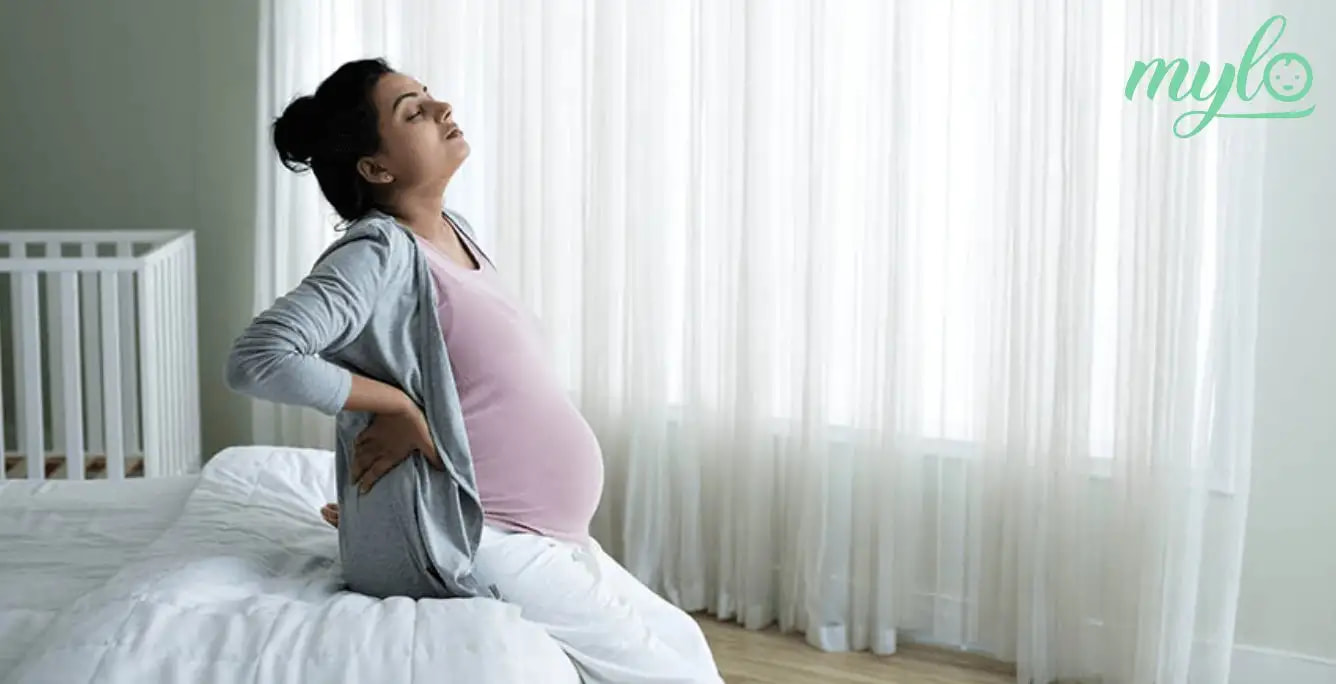Home

Sciatica During Pregnancy: Causes & Treatment
In this Article

Pregnancy
Sciatica During Pregnancy: Causes & Treatment
Updated on 27 March 2023
It is normal to experience pain in the lower back during pregnancy. However, if the pain intensifies then there are chances that you have sciatica. Generally, about 5% of pregnant women get sciatica during pregnancy. Sciatica involves damage to any of the spinal discs, combined with swelling and throbbing pain. In this article, we will understand in detail pregnancy sciatica, its symptoms, causes and treatment.
What is Sciatica?
Sciatica happens when your back exerts pressure and compresses on the sciatic nerve. If it prolongs then it causes injury to the spine as well as herniated, bulging and dislocated spinal discs. The sciatic nerve is the largest one in the entire body and it connects your back, thighs neck and other major parts of your body. Sciatica is also medically referred to as the lumbosacral radicular syndrome. When your spinal discs exert pressure on the sciatic nerve, then you will experience severe pain, discomfort and inability to move freely.
Symptoms of Sciatica During Pregnancy
The symptoms of sciatica during pregnancy are similar to that which is experienced with pelvic girdle pain. However, sciatica causes more severe pain and affects daily life. The pain continues for several days if left untreated or it occurs at regular intervals.
Below are the common symptoms of sciatica during pregnancy:
-
It affects your lower back and one side of the body below the belt.
-
You can experience pain in the legs, thighs, hips, and up to feet.
-
The sciatica symptoms are experienced while walking, running and bending down.
-
Burning sensation and tingling feeling are felt in the legs.
-
Aggravated sciatica causes symptoms such as numbness or a feeling of pins and needles on the leg and foot area.
-
Inability to sit due to severe pain in the legs.
-
Shooting pain that affects one side of the body.
-
Difficulty to move the feet and legs.
-
Difficulty walking due to the severity of sciatica pain.
Causes of Sciatica During Pregnancy
It is important to keep in mind not to panic if you are diagnosed with sciatica. Pregnant women experience sciatica during the second and third trimesters of pregnancy. There are several reasons that cause sciatica during pregnancy. They include the following:
1. Muscle tension
Pregnancy causes high muscle tension in pregnant women and they begin to experience sciatica symptoms. This happens due to the gradual growth and development of the baby.
2. Piriformis syndrome
The piriformis syndrome is caused as a result of the tension in the buttocks muscle. It is most common in pregnant women due to overweight and the pressure exerted on this muscle.
3. Instability of the joints
Pregnancy and the resulting overweight causes pressure and swelling of the joints that causes sciatica symptoms and the inability to move freely.
4. Pain in the pelvic bone
Pregnancy causes additional pressure on the regions surrounding the pelvic bone. This happens during the second and third trimesters of pregnancy. During pregnancy, the relaxin hormone is released in the body of the pregnant women which makes the ligaments to loosen and stretch in and around the pelvic area as well as the entire body.
5. The weight of your baby
The weight of the baby as it grows and develops within your Womb causes sciatica symptoms. This is caused as a result of the pressure exerted by the baby directly on the sciatic nerve as well as on the hip and pelvic bones.
6. Sacroiliac joints
Damage to the sacroiliac joint causes a pregnant woman to experience sciatica pain.
7. Fluid retention during pregnancy
Generally, pregnant women retain an excess of fluid within the body. The excess fluid retention causes pressure to be put on the sciatic nerve. The pelvic bone puts compressions on it thereby causing more pain.
8. Pressure from the uterus
During pregnancy, the uterus grows and continues to expand with the growth and development of the baby. If there is an abnormal growth then excessive pressure is exerted on the disks damaging and herniating it, while causing dislodges and bulges in the spinal discs. The gel in the spine leaks out causing spinal disc bulges due to the pressure exerted and compressing it.
9. The center of gravity of the body changes
With pregnancy and the excessive weight as a result of the growth of the pregnant woman's breast and womb, the center of gravity of the woman's body changes. This lessens the pressure and compresses on the sciatic nerve while tensing up the muscles of the pelvis and the buttocks regions. When the center of gravity of the body of the pregnant women changes it leads to the lordotic area to curve abnormally, adding pressure on the sciatic nerve.
10. Movements and position of the baby
Certain movements of the baby and the position that the baby occupies to enter into the birthing position within the mother's womb during the third trimester cause pressure to be exerted on the sciatic nerve. In such a situation the head of the fetus is on the sciatic nerve causing severe pain.
11. Tumors
Sciatica is also caused as a result of a tumor that already existed and the addition of the fetus weight can cause pressure on the sciatic nerve.
12. Excessive bleeding
Pregnancy can cause excessive bleeding which would put a strain on sciatica and cause severe pain.
Being aware of the causes and the symptoms of sciatica during pregnancy can enable a pregnant woman to carefully maintain her body weight and prevent such a painful condition.
How to Deal With Sciatica During Pregnancy?
Generally, a pregnant woman with sciatica is able to recover within 12 weeks. However, it depends on the severity and duration. If the sciatica is severe then it could take about six months to recover after delivery. If you are experiencing sciatica during pregnancy, then it is important that you consult and follow the directions of a musculoskeletal physiotherapist.
Treatment for Sciatica During Pregnancy
Here are some ways to treat sciatica pain in pregnancy:
-
Do physical therapy exercises that help in the strengthening of the muscles in and around the pelvic areas of the back and the stomach. This helps in reducing the pain and discomfort caused as a result of sciatica.
-
Wear a belt that supports your belly and back so as to prevent further aggravation of the pain and swelling.
-
Your doctor will prescribe anti-inflammatory medications, muscle relaxants and painkillers that are safe to take during pregnancy.
-
Book yourself for a prenatal massage done by a musculoskeletal physiotherapist who can help in relieving the pain and swelling caused due to sciatica.
-
The other therapies that you can make use of to relieve the symptoms include acupuncture, chiropractic, osteopathy, and massages.
-
It is important that you take the treatment under the monitoring of a registered practitioner who is well-experienced in treating sciatica pain in pregnancy.
Risk Factors of Sciatica During Pregnancy
There are several risk factors that can lead to pregnancy sciatica. Pregnant women are more prone to it when:
- a pregnant woman does not maintain control over her body weight.
- sitting or standing for long periods of time.
- smoking and drinking habits.
- osteoporosis and brittle bones.
- continuous pain in the back and joints.
- injury and damage to the lumbar spine and the spinal discs.
- bad sitting, standing, and sleeping postures.
- lazily lying down all the time without doing daily physical exercises and activities.
- the absence of a healthy diet.
- insufficient intake of vitamins, and minerals derived from fruits and vegetables.
- lifting and carrying heavy objects during pregnancy that strain the backbone and the surrounding discs.
- lack of support for the back while sitting.
- sleeping on bumpy surfaces.
- wearing high heels shoes during pregnancy.
You can adopt a healthier lifestyle during pregnancy with Mylo Pregnancy Care Routine which includes pregnancy yoga sessions, Garbha Sanskar sessions and consultation with gynecologists and health coaches. It can help you manage your weight trimester wise, reduce backache and leg swelling, boost energy levels and manage gestational diabetes and BP.
Getting rid of sciatica during pregnancy completely is impossible as it is inherent and occurs within the spinal discs. However, being able to identify the risk factors and avoid them, along with proper care, exercise, daily practice of yoga, and engaging in active physical activities can prevent it.



Written by
Mylo Editor
Official account of Mylo Editor
Read MoreGet baby's diet chart, and growth tips

Related Articles
RECENTLY PUBLISHED ARTICLES
our most recent articles

Illnesses & Infections
Heat Rash in Babies: Symptoms, Risks & Treatments

Scans & Tests
Amniocentesis: Meaning, Risks & Results

Umbilical Cord
Umbilical Cord: Risks, Benefits & Recovery

Stretch Marks
Stretch Marks Removal: Tips & Remedies

Fussy Baby
How Can Dads Calm A Fussy Toddler

General Father
How to prepare your older child for a new baby
- 5 Financial Moves You Must Make Before Your Baby Arrives
- Daddy-Baby bonding from Pregnancy to Childbirth: Top 7 tips for you
- How to prepare your child for pre-school
- I am pregnant, can I still breastfeed my toddler?
- My toddler has bad breath. what should I do?
- When will my toddler learn how to scribble or draw?
- Can loud volume affect my toddler's ears?
- Running & Jumping Milestones for your toddler
- Activities to keep an active toddler occupied at home
- Girls' growth chart: 24 to 36 months
- What to do if your toddler is overweight?
- Electric toothbrush for Toddlers: Is it safe?
- Teaching good eating habits to your kids
- How to Introduce Books to Your Child?


AWARDS AND RECOGNITION

Mylo wins Forbes D2C Disruptor award

Mylo wins The Economic Times Promising Brands 2022
AS SEEN IN
















- Mylo Care: Effective and science-backed personal care and wellness solutions for a joyful you.
- Mylo Baby: Science-backed, gentle and effective personal care & hygiene range for your little one.
- Mylo Community: Trusted and empathetic community of 10mn+ parents and experts.
Product Categories
baby carrier | baby soap | baby wipes | stretch marks cream | baby cream | baby shampoo | baby massage oil | baby hair oil | stretch marks oil | baby body wash | baby powder | baby lotion | diaper rash cream | newborn diapers | teether | baby kajal | baby diapers | cloth diapers |








